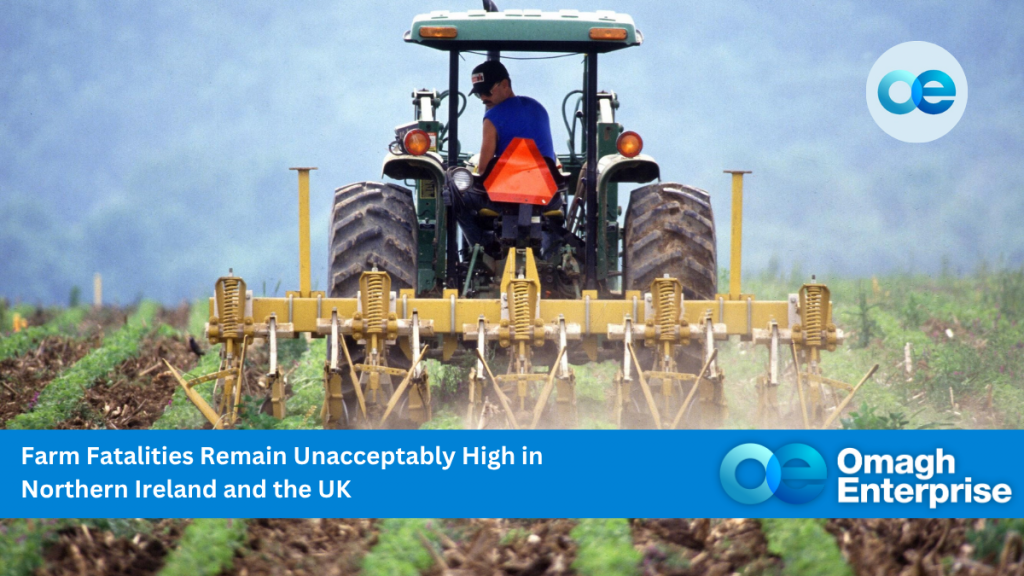Despite ongoing awareness campaigns and improved training, fatal injuries in agriculture continue to lag, both across the UK and in Northern Ireland.
📊 UK‐Wide Safety Overview
-
In Great Britain during the year to March 2024, 27 people lost their lives due to farm‑related activities — 23 in agriculture, and the rest in forestry or fishing. Agriculture continues to have the worst fatality rate of any primary sector hse.gov.uk.
-
On average, fatalities in agriculture occur 21 times more often than in other industries—in part due to ageing workforce and high-risk operations HSE Media Centre.
-
Transport incidents—especially involving tractors and ATVs—are the leading cause (~28 %), followed by livestock injuries (~15 %), machinery incidents (~14 %), falls (~15 %), and being struck by objects (~15 %) JMW Solicitors.
Northern Ireland Snapshot
-
Although fatalities have dropped from around 12 per year in the early 2010s to around 8 annually by 2018, farm safety remains the poorest among occupations here hseni.gov.uk.
-
Livestock and machinery are frequent culprits. Surveys from 2015 suggest hundreds of hospital-treated incidents per month, with many never formally reported hseni.gov.uk.
Why This Still Matters for Omagh Farmers
1. Same Dangers, Same Stakes
Northern Ireland faces many of the same hazards: cattle handling, tractor work, steep slopes and silage pits. These risks don’t distinguish county borders.
2. An Ageing Farming Community
As in Great Britain, older workers (45+) account for around 80 % of farm fatalities. This demographic trend is consistent in Ulster communities as well HSE.
3. Under‑Reporting of Lesser Injuries
Most minor and moderate injuries go unrecorded. Nationally, only around 16 % of reportable injuries are officially notified—suggesting true incident numbers are far higher HSE.
What Omagh Farms Can Do
🔧 1. Prioritise Tractor & Vehicle Safety
-
Encourage use of ROPS (Rollover Protection Structures) and seat belts on tractors—shown to prevent nearly all overturn fatalities Wikipedia.
-
Helmets and roll cages for quad bikes reduce severe injury risk—NFU advocates consider them “easy wins” NFU.
🐄 2. Reinforce Livestock Safety Protocols
-
Make “working with cattle” a core focus during safety briefings.
-
Campaigns like HSE’s Your Farm Your Future offer practical tips to separate handlers from animals and anticipate reaction triggers Farming Life.
📋 3. Record Near-Misses and Safety Failures
-
Near-miss logging is critical. Learning from “lucky escapes” helps prevent future tragedy—and is a key campaign goal in Farm Safety Week NFU Online.
👥 4. Be Culturally Committed: “Stop and Think SAFE”
-
Northern Ireland’s ‘Safe: Slurry, Animals, Falls, Equipment’ campaign urges a safety-first mindset—not a box-ticking exercise Health and Safety Executive.
-
NFU and Yellow Wellies encourage simple habits like the “Take 5 to Stay Alive” pause before risky tasks fwi.co.uk.
Bringing It Home to Omagh
For farms around Omagh and the Tyrone countryside, these lessons are highly relevant:
-
Review tractor roll bars and seat belts on older machinery.
-
Ensure livestock handling pens, gates, and escape routes are robust.
-
Run safety briefings ahead of field season—especially before busy times like harvest.
-
Log near-misses and encourage staff to speak up without fear of blame.
-
Share short clips or flyers from HSE’s livestock safety campaign at local marts or clinics.
In Summary
| Issue | UK/Northern Ireland Context | Relevance for Omagh Farms |
|---|---|---|
| Fatalities | ~27 fatalities in GB annually; ~8 in NI | Risks remain in local hubs like Omagh |
| Main Causes | Transport (28 %), livestock (15 %), machinery/falls (~14–15 %) | Similar hazards faced in local operations |
| Reporting Gap | Only ~16 % of injuries officially logged | True incident rates likely much higher locally |
| Age Profile | 80 % of fatalities among older workers | Omagh has a high proportion of experienced older farmers |
🔐 Bottom Line
Despite improvements over time, farm safety in Northern Ireland—and especially around Omagh—remains in urgent need of cultural and practical change. Simple, no-cost actions like risk pauses, logging near-misses, and enforcing basic PPE can make a life-or-death difference.
Let this be a call to action: not just compliance, but true safety leadership in our farms.
Sources cited above are based on official HSE and related UK industry data.




